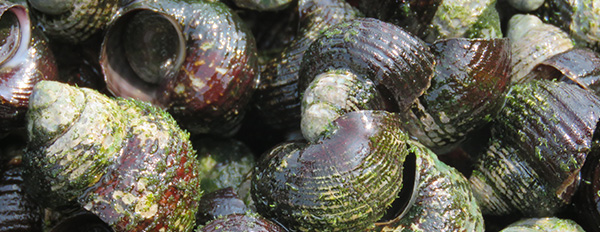“Golden kuhol” is native to South America and was introduced to farmers in the Philippines in the 1980s from Argentina via Taiwan, to increase farmers’ income and enrich the protein in their diet. However, this species became a pest in the rice fields, eating young seedlings and laying many eggs, capable of damaging whole ricelands when not controlled. It is listed as one of the world’s 100 worst invasive alien species (IAS) and in the Philippines, it causes a yearly crop damage estimated at USD1200 million per annum aside from negative impacts on health and environment.
In Tabuk, Kalinga, the rice bowl of the Cordillera Region, where the “modern” and chemical-based farming is prevalent, people resorted to the use of pesticides to control the golden snail but the use of pesticides resulted in additional health hazards (e.g. skin disorders, peeling of nails in the feet and hands, swelling, blindness, and the swelling of reproductive organs in women).
When the snail was introduced in Sagada, Mountain Province in the 90s, it was also seen as one of the worst pests in the ricelands. Aside from damaging or killing rice seedlings, the people attribute the disappearance of about 6 species of edible snails, the mudfish and the “saksaknong”, an edible wild plant, to the golden kuhol. People believe that the golden snails eat the eggs of the local snails and fish. Their disappearance is a loss of diversity of food sources available in the communities.
The tradition of sharing of knowledge and discoveries on ways and means of pest control helped the farmers. Manual picking was first employed, then combined with water management and use of older seedlings.
Eventually, people adapted to the taste of the snail and included this in their diet. These control mechanisms are made more efficient with the practice of community rituals. The rice production cycle opens with the ritual of begnas di lakat which is a go signal to start the land preparation. During this time farmers collect and kill the snails, they hunt for the eggs and crush them. While done in individual farms, it results in a collective action throughout the whole rice landscape.
By the 21st century, the snail was seen as beneficial as it now serves as food, and women need not weed the rice fields because the weeds are eaten by the snail.
However, the snail has now become a major obstacle in the promotion of systems rice intensification (SRI) which has been proven to increase rice yield by three to five times. One fundamental principle of the SRI is to plant young seedlings of 18 to 22 days and these are very vulnerable to the golden apple snail.
For more information please contact: This email address is being protected from spambots. You need JavaScript enabled to view it.

